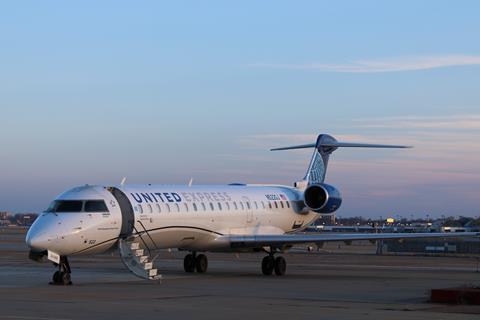Rick Leach, chief executive of GoJet Airlines, sees a rare opportunity in front of the St Louis-based regional carrier created by slackening demand for pilots among its major US counterparts.
With some cadet classes cancelled at flight schools and major airlines announcing pilot furloughs and hiring pauses, a “hesitation in the market” is creating an unusual respite for regional carriers – a weakening of forces that typically pull pilots away, Leach tells FlightGlobal.
“There’s an opportunity for us to capture some of that talent, keep some of our talent, get the machine healthier,” Leach says. “Right now, we feel like it’s time to send a very strong statement and get that done.”
GoJet – which operates exclusively under the United Express brand on behalf of United Airlines – is offering a “direct entry” bonus of $175,000 for captains, and an additional $25,000 bonus for pilots with a Part 121 type rating.
The package is ”paid out within the first 12 months without any contractual obligations or strings attached”, GoJet says.
The programme is aimed at hiring enough captains to add dozens of aircraft to GoJet’s operational fleet of Bombardier CRJ-family regional jets, with Leach touting the company’s “100% growth” potential.
“We’re adding over 40 aircraft to our fleet, over doubling it,” he says. “That’s significant.”

Cirium fleets data show that GoJet currently has 35 CRJ700s in service. Leach says it is contracted to fly up to 74 jets for United.
GotJet is adding such a high volume of aircraft by modifying older CRJ700 fuselages, acquired prior to the Covid-19 pandemic, into the smaller CRJ550 variant and returning the jets to service.
“These are existing aircraft that we acquired under our certificate by design, but they’ve never been in the air for us,” he says. “These are fuselages of aircraft that we acquired because we needed to – I’m not going to say corner the market – but we needed to get as many of 700 resources that were available so we could get the aircraft modified into 550s and get the aircraft in the air. Covid hit and everything stalled.”

“We acquired a lot of fuselages because 700s aren’t built anymore,” he continues “That’s the fuselage that we build and convert into the 550. So we have these aircraft – this contracted growth on the table. The key is to get that in the air as quickly as possible.”
GoJet is not the only regional US carrier seeking to capitalise on the shifting market dynamics and get more aircraft into service. American Airlines’ regional subsidiary PSA Airlines is also dangling up to $175,000 in singing bonuses for direct-entry captains.
”Our successful efforts to attract and retain top aviation talent – from the cockpit to the cabin and the hangar – have enabled us to restore 15 aircraft back into revenue-generating service, bringing our total number of revenue-generating aircraft to 98,” PSA tells FlightGlobal. ”We’re optimistic that we will be able to bring another 16 aircraft into service by the end of the year.”
Regional carriers have struggled most acutely with the pilot shortage that until recent months withheld airlines from growing fast enough to meet post-pandemic demand, driving major carriers to poach pilots from smaller regional airlines.
But now major US airlines are slowing pilot hiring for the first time in years. Dallas-based Southwest Airlines, for example, has initiated a hiring freeze and is encouraging pilots to take unpaid time off.
For GoJet and other regional carriers in the USA, captains remain a crucial pinch point. “All of this is a focus on getting more captains to match our [first officer] resources, which are significant,” Leach says.
More captains would allow GoJet to get more aircraft in service and fly more block hours, creating more opportunity for its first officers to accrue the 1,000h minimum requirement to upgrade to captain. Leach hopes to attract enough direct-entry captains – and for enough first officers to upgrade to captain – to get one or two CRJ550s off the ground monthly.
“My hope is that we are going to get the majority of these aircraft in the air towards late next year or at the latest early 2026,” he says.
GoJet’s priority is on getting its CRJ fleet fully operational, but it will eventually have to consider replacing its ageing regional jets. Leach maintains that there is still plenty of life left in its existing aircraft, all of which are between about 15- and 20-years old.
“Obviously, we have experience with all the other aircraft types and brands,” Leach says, ”but right now we are laser-focused on meeting United’s operational and market objectives by getting all of these aircraft in the air.”
























